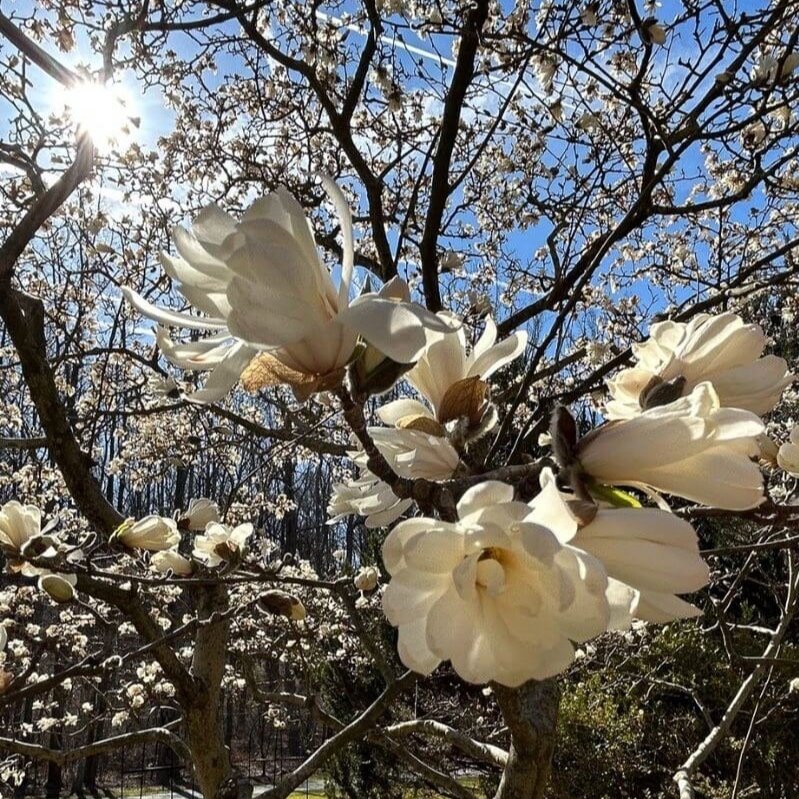The ‘Little Girl’ Magnolias
Meet the ‘Little Girl’ Magnolias and their Frost Resistant Flowers
Magnolia ‘Ann’, ‘Betty’, ‘Jane’, ‘Judy’, ‘Pinkie’, ‘Randy’, ‘Ricki’, and ‘Susan’
Avoid frost damage with one of these small magnolia trees!
This post contains affiliate links, marked with an asterisk (*). If you click the link, I may receive a small commission at no extra cost to you - please see my policy on affiliate links. Thank you for supporting this blog!
The ‘Little Girl’ magnolias are a group of magnolia cultivars developed by the U.S. Arboretum to avoid the frost damage frequently seen on other early-blooming deciduous magnolias.
There are eight altogether - ‘Ann’, ‘Betty’, ‘Jane’, ‘Judy’, ‘Pinkie’, ‘Randy’, ‘Ricki’, and ‘Susan’. All are erect, shrub-like small trees with tulip-like flowers in varying shades of purple-red. The most popular and easiest to find are ‘Ann’, ‘Jane’, and ‘Susan’.
All cultivars have fuzzy flower buds on smooth gray bark, which open in early spring, and leathery green leaves emerging when flowering has finished. Flowers may occasionally reappear during the summertime.
The blooming period of these magnolia varieties occurs 2-4 weeks after the star magnolia (Magnolia stellata) and the saucer magnolia (Magnolia x soulangeana), minimizing the risk of damage from spring frost. Little Girl magnolias are hardy in zones 3b to 8.
Plant ‘Little Girl’ magnolias in full sun and rich, moist soil. As with all trees and shrubs, make sure to water deeply and frequently during the first two years, to help the plant become established.
Apply a layer of mulch around the base of the magnolia to help retain moisture and regulate the soil temperature. Keep mulch a few inches away from the trunk to prevent rot.
The cup-shaped, tulip-like flowers of Magnolia ‘Jane’.
Magnolias prefer consistently moist soil, especially during the first few years of establishment (for more information on watering, read “How to Water a Tree”).
Magnolias require little, if any, pruning. Prune in late spring, when flowering has completed, to shape lightly and remove dead or damaged branches.
The Little Girl magnolias are very adaptable and easy to grow. Scale, canker, powdery mildew and leaf spots can be occasional problems. Consult with an arborist if you notice problems with your magnolia tree.
Treat the ‘Little Girl’ Magnolia as a large shrub or small tree. Plant in the back of a border garden, or in front of an evergreen screening hedge.
Use as a specimen, next to a patio, or as the focal point of a garden bed. The upright spreading shape of this plant makes it a great choice for the corner of a house, for a foundation planting, or next to a fence.
If you have a larger outdoor space, plant one as part of a grouping or with other spring-flowering trees like redbud and the Okame cherry.
👉 * Buy Magnolia Ann from Fast Growing Trees * 👈
👉 * Buy Magnolia Jane from Fast Growing Trees * 👈
The perfect tree to plant close to the house.
Which is the Best Small ‘Little Girl’ Magnolia Tree?
The Little Girl magnolia cultivars can be hard to tell apart. ‘Ann’, ‘Jane’, and ‘Susan’ are the most popular and are widely available at nurseries and garden centers. ‘Jane’ and ‘Susan’ are more tree-like; ‘Ann’ forms a large, compact shrub. ‘Jane’ is the tallest; ‘Judy’ is the smallest; ‘Betty’ is the widest.
‘Ann’ is an early bloomer with reddish purple flowers. Grows 10-12 feet tall and 15 feet wide with a compact, multi-stemmed shrub-like shape.
‘Betty’ blooms in mid-spring, with large reddish-purple flowers with white insides. Forms a wide, round, large shrub up to 15 feet tall and 20 feet wide.
‘Jane’ has late spring, deep purple flowers with white interiors. Grows into a multi-stemmed, upright small tree, up to 20 feet tall.
‘Judy’ is a mid-spring bloomer sporting reddish purple flowers with cream-colored interiors. Forms a rounded shrub up to 9 feet tall and 13 feet wide.
‘Pinkie’ is a late spring bloomer with pale purple flowers with white interiors. Grows into a round, multi-stemmed shrub up to 10 feet tall and 20 feet wide.
‘Randy’ and ‘Ricki’ are midseason bloomers with a shrublike form and reddish purple flowers with white interiors. Grows up to 10 feet tall and 16 feet wide.
‘Susan’ has fragrant, slightly twisted deep purple with soft white interiors. Forms an upright, small tree and grows up to 15 feet tall and wide.
👉 * Buy Magnolia Ann from Fast Growing Trees * 👈
👉 * Buy Magnolia Jane from Fast Growing Trees * 👈
The Little Girl magnolias leaf out after flowering.
Are the ‘Little Girl Magnolias’ Deer-Resistant?
Little Girl Magnolia trees are considered deer-resistant because their leathery leaves and slightly bitter taste tend to discourage browsing.
However, as with all plants, "deer-resistant" doesn't mean "deer-proof"—when food is scarce, especially in winter or drought conditions, hungry deer may still nibble on them.
Young magnolias are particularly vulnerable, as their tender new growth can be more appealing to desperate deer.
To protect your trees, consider using physical barriers like fencing, netting, or individual plant cages, especially during their early years of growth.
The ‘Little Girl’ magnolias are adaptable, low-maintenance flowering trees for small gardens.
Find a Tree for Your Landscape:

























This stately, deciduous conifer thrives in zones 4-9.